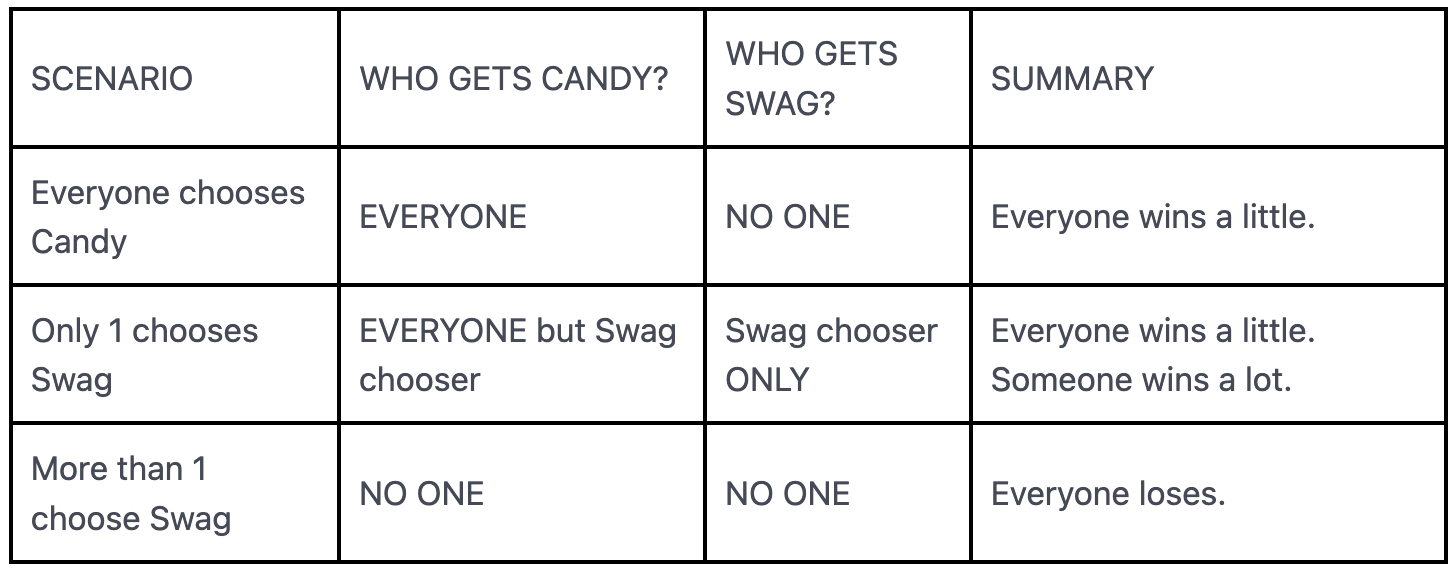Candy or Swag
Demonstrate the value of open organization principles like collaboration and transparency
Jim Barton
What Is Candy or Swag?
The "Candy or Swag?" practice uses a game environment to reinforce critical open organization values like collaboration and transparency. The goal is to demonstrate how that, even in the simplest group scenarios, outcomes improve for everyone when members of self-organizing teams collaborate and hold each other accountable for results.
Why Do Candy or Swag?
When new teams are forming, especially in traditional organizations with siloed legacies, there is a need to establish open organization values like collaboration and transparency. This practice delivers these messages in an engaging game environment.
In addition, if your organization distributes swag like team or project t-shirts when embarking on a new initiative, this practice provides a much more memorable delivery experience than simply leaving an open box in a conference room.
How to do Candy or Swag?
Prerequisites
- Candy: Enough individual pieces of candy for each participant for the number of game rounds expected. Example: 10 participants * 5 rounds = 50 pieces of candy. Note that it doesn't have to be candy. It could be any item expected to be of significantly lower value to the participants than the Swag.
- Swag: 1 piece of swag per student (plus spares). This is the higher value prize. Possibilities include t-shirts, phone chargers, pens, etc.
- Cards: 2 index cards per student. One card says "Candy"; the other says "Swag".
Steps
The game proceeds through multiple sets of rounds, each of which is used in illustrating open organization principles.
Phase 1: Control
First, explain the rules of the game:
- NO TALKING. If you talk, you get neither Candy nor Swag.
- You have two cards in front of you. For each round, choose either the Candy or Swag card and show only me your choice as I walk around the room.
- Here's how we determine who gets what:

NOTE: For larger groups, you may want to increase the number of allowable Swag choosers per round. See the slide set referenced below for recommended guidelines.
What typically happens in Phase 1 is that multiple people will choose Swag in each round, so no one gets anything. Run at least two rounds in this phase to build some frustration among the group. Allow some reflection at the end of this phase where you compare this to a typical project development process, where cross-functional expertise is locked in organizational silos that seldom or never communicate with one another.
Phase 2: Collaboration
Review the principles of open source and ask if communication might help everyone achieve better outcomes. Phase 2 adds an element of collaboration to the game.
Announce that the group will have one minute from when I say "go" to collaborate before you choose CANDY or SWAG. I'll hold up signs telling you when you have 30 seconds left, then 20 seconds left, then count down the last ten. Then the game proceeds exactly as before.
This is where things get interesting. I've seen groups attempt to establish some sharing protocol to ensure that someone gets swag every round: randomly, according to need, alphabetical order of names, etc. Sometimes it works; often it doesn't.
Run at least 2-3 rounds in this phase. If the group figures out how to cooperate by this point, you can add another variant by having a pre-planted "bad actor" in the group. Activate the "bad actor" secretly for a final round and watch the frustration build again.
In the reflection on this phase, the group will generally agree that collaboration produced better results for everyone. However, a lone "bad actor" could still ruin the outcomes for everyone. Solicit ideas on ways the sabotage could be prevented. That should provide a segue into the final Transparency phase of the game.
Phase 3: Transparency
Phase 3 proceeds by allowing everyone a minute to collaborate as before. But this time, the choice of Candy or Swag cards is not hidden from the group. Instead, when the GO signal is given, everyone places their card face-up on the table.
Reflect on how the combination of collaboration and transparency achieved better outcomes for everyone. Those are two of the core principles we live by in open organizations.
Distribute the SWAG!
Finally, distribute swag to everyone who hasn't already received it.
Look at Candy or Swag
Links we love
Check out these great links which can help you dive a little deeper into running the Candy or Swag practice with your team, customers or stakeholders.
